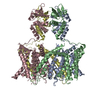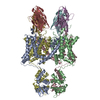+ Open data
Open data
- Basic information
Basic information
| Entry |  | |||||||||
|---|---|---|---|---|---|---|---|---|---|---|
| Title | Structure of human Kv1.3 | |||||||||
 Map data Map data | Human Kv1.3 | |||||||||
 Sample Sample |
| |||||||||
 Keywords Keywords | ion channel / IMMUNE SYSTEM | |||||||||
| Function / homology |  Function and homology information Function and homology informationvoltage-gated monoatomic ion channel activity / delayed rectifier potassium channel activity / Voltage gated Potassium channels / action potential / voltage-gated potassium channel activity / voltage-gated potassium channel complex / potassium ion transmembrane transport / bioluminescence / generation of precursor metabolites and energy / protein homooligomerization ...voltage-gated monoatomic ion channel activity / delayed rectifier potassium channel activity / Voltage gated Potassium channels / action potential / voltage-gated potassium channel activity / voltage-gated potassium channel complex / potassium ion transmembrane transport / bioluminescence / generation of precursor metabolites and energy / protein homooligomerization / potassium ion transport / axon / perinuclear region of cytoplasm / membrane / plasma membrane Similarity search - Function | |||||||||
| Biological species |  Homo sapiens (human) / Homo sapiens (human) /  | |||||||||
| Method | single particle reconstruction / cryo EM / Resolution: 2.89 Å | |||||||||
 Authors Authors | Meyerson JR / Selvakumar P | |||||||||
| Funding support |  United States, 1 items United States, 1 items
| |||||||||
 Citation Citation |  Journal: Nat Commun / Year: 2022 Journal: Nat Commun / Year: 2022Title: Structures of the T cell potassium channel Kv1.3 with immunoglobulin modulators. Authors: Purushotham Selvakumar / Ana I Fernández-Mariño / Nandish Khanra / Changhao He / Alice J Paquette / Bing Wang / Ruiqi Huang / Vaughn V Smider / William J Rice / Kenton J Swartz / Joel R Meyerson /  Abstract: The Kv1.3 potassium channel is expressed abundantly on activated T cells and mediates the cellular immune response. This role has made the channel a target for therapeutic immunomodulation to block ...The Kv1.3 potassium channel is expressed abundantly on activated T cells and mediates the cellular immune response. This role has made the channel a target for therapeutic immunomodulation to block its activity and suppress T cell activation. Here, we report structures of human Kv1.3 alone, with a nanobody inhibitor, and with an antibody-toxin fusion blocker. Rather than block the channel directly, four copies of the nanobody bind the tetramer's voltage sensing domains and the pore domain to induce an inactive pore conformation. In contrast, the antibody-toxin fusion docks its toxin domain at the extracellular mouth of the channel to insert a critical lysine into the pore. The lysine stabilizes an active conformation of the pore yet blocks ion permeation. This study visualizes Kv1.3 pore dynamics, defines two distinct mechanisms to suppress Kv1.3 channel activity with exogenous inhibitors, and provides a framework to aid development of emerging T cell immunotherapies. | |||||||||
| History |
|
- Structure visualization
Structure visualization
| Supplemental images |
|---|
- Downloads & links
Downloads & links
-EMDB archive
| Map data |  emd_25416.map.gz emd_25416.map.gz | 117.7 MB |  EMDB map data format EMDB map data format | |
|---|---|---|---|---|
| Header (meta data) |  emd-25416-v30.xml emd-25416-v30.xml emd-25416.xml emd-25416.xml | 14.2 KB 14.2 KB | Display Display |  EMDB header EMDB header |
| FSC (resolution estimation) |  emd_25416_fsc.xml emd_25416_fsc.xml | 11.5 KB | Display |  FSC data file FSC data file |
| Images |  emd_25416.png emd_25416.png | 108.1 KB | ||
| Filedesc metadata |  emd-25416.cif.gz emd-25416.cif.gz | 5.6 KB | ||
| Others |  emd_25416_additional_1.map.gz emd_25416_additional_1.map.gz emd_25416_additional_2.map.gz emd_25416_additional_2.map.gz | 4.4 MB 4.2 MB | ||
| Archive directory |  http://ftp.pdbj.org/pub/emdb/structures/EMD-25416 http://ftp.pdbj.org/pub/emdb/structures/EMD-25416 ftp://ftp.pdbj.org/pub/emdb/structures/EMD-25416 ftp://ftp.pdbj.org/pub/emdb/structures/EMD-25416 | HTTPS FTP |
-Validation report
| Summary document |  emd_25416_validation.pdf.gz emd_25416_validation.pdf.gz | 511.8 KB | Display |  EMDB validaton report EMDB validaton report |
|---|---|---|---|---|
| Full document |  emd_25416_full_validation.pdf.gz emd_25416_full_validation.pdf.gz | 511.4 KB | Display | |
| Data in XML |  emd_25416_validation.xml.gz emd_25416_validation.xml.gz | 12 KB | Display | |
| Data in CIF |  emd_25416_validation.cif.gz emd_25416_validation.cif.gz | 16 KB | Display | |
| Arichive directory |  https://ftp.pdbj.org/pub/emdb/validation_reports/EMD-25416 https://ftp.pdbj.org/pub/emdb/validation_reports/EMD-25416 ftp://ftp.pdbj.org/pub/emdb/validation_reports/EMD-25416 ftp://ftp.pdbj.org/pub/emdb/validation_reports/EMD-25416 | HTTPS FTP |
-Related structure data
| Related structure data |  7ssxMC  7ssyMC  7ssvC  7sszC  8dflC M: atomic model generated by this map C: citing same article ( |
|---|---|
| Similar structure data | Similarity search - Function & homology  F&H Search F&H Search |
| EM raw data |  EMPIAR-11071 (Title: Human Kv1.3 / Data size: 1.4 TB / Data #1: Human Kv1.3 dataset 1 [micrographs - multiframe] / Data #2: Human Kv1.3 dataset 2 [micrographs - multiframe] / Data #3: Human Kv1.3 dataset 3 [micrographs - multiframe]) EMPIAR-11071 (Title: Human Kv1.3 / Data size: 1.4 TB / Data #1: Human Kv1.3 dataset 1 [micrographs - multiframe] / Data #2: Human Kv1.3 dataset 2 [micrographs - multiframe] / Data #3: Human Kv1.3 dataset 3 [micrographs - multiframe]) |
- Links
Links
| EMDB pages |  EMDB (EBI/PDBe) / EMDB (EBI/PDBe) /  EMDataResource EMDataResource |
|---|---|
| Related items in Molecule of the Month |
- Map
Map
| File |  Download / File: emd_25416.map.gz / Format: CCP4 / Size: 125 MB / Type: IMAGE STORED AS FLOATING POINT NUMBER (4 BYTES) Download / File: emd_25416.map.gz / Format: CCP4 / Size: 125 MB / Type: IMAGE STORED AS FLOATING POINT NUMBER (4 BYTES) | ||||||||||||||||||||||||||||||||||||
|---|---|---|---|---|---|---|---|---|---|---|---|---|---|---|---|---|---|---|---|---|---|---|---|---|---|---|---|---|---|---|---|---|---|---|---|---|---|
| Annotation | Human Kv1.3 | ||||||||||||||||||||||||||||||||||||
| Projections & slices | Image control
Images are generated by Spider. | ||||||||||||||||||||||||||||||||||||
| Voxel size | X=Y=Z: 0.852 Å | ||||||||||||||||||||||||||||||||||||
| Density |
| ||||||||||||||||||||||||||||||||||||
| Symmetry | Space group: 1 | ||||||||||||||||||||||||||||||||||||
| Details | EMDB XML:
|
-Supplemental data
-Additional map: Human Kv1.3 (single subunit, D1 conformation)
| File | emd_25416_additional_1.map | ||||||||||||
|---|---|---|---|---|---|---|---|---|---|---|---|---|---|
| Annotation | Human Kv1.3 (single subunit, D1 conformation) | ||||||||||||
| Projections & Slices |
| ||||||||||||
| Density Histograms |
-Additional map: Human Kv1.3 (single subunit, D2 conformation)
| File | emd_25416_additional_2.map | ||||||||||||
|---|---|---|---|---|---|---|---|---|---|---|---|---|---|
| Annotation | Human Kv1.3 (single subunit, D2 conformation) | ||||||||||||
| Projections & Slices |
| ||||||||||||
| Density Histograms |
- Sample components
Sample components
-Entire : Kv1.3
| Entire | Name: Kv1.3 |
|---|---|
| Components |
|
-Supramolecule #1: Kv1.3
| Supramolecule | Name: Kv1.3 / type: complex / ID: 1 / Parent: 0 / Macromolecule list: #1 |
|---|---|
| Source (natural) | Organism:  Homo sapiens (human) Homo sapiens (human) |
-Macromolecule #1: Potassium voltage-gated channel subfamily A member 3, Green fluor...
| Macromolecule | Name: Potassium voltage-gated channel subfamily A member 3, Green fluorescent protein fusion type: protein_or_peptide / ID: 1 / Number of copies: 4 / Enantiomer: LEVO |
|---|---|
| Source (natural) | Organism:  |
| Molecular weight | Theoretical: 95.0185 KDa |
| Recombinant expression | Organism:  Homo sapiens (human) Homo sapiens (human) |
| Sequence | String: MDERLSLLRS PPPPSARHRA HPPQRPASSG GAHTLVNHGY AEPAAGRELP PDMTVVPGDH LLEPEVADGG GAPPQGGCGG GGCDRYEPL PPSLPAAGEQ DCCGERVVIN ISGLRFETQL KTLCQFPETL LGDPKRRMRY FDPLRNEYFF DRNRPSFDAI L YYYQSGGR ...String: MDERLSLLRS PPPPSARHRA HPPQRPASSG GAHTLVNHGY AEPAAGRELP PDMTVVPGDH LLEPEVADGG GAPPQGGCGG GGCDRYEPL PPSLPAAGEQ DCCGERVVIN ISGLRFETQL KTLCQFPETL LGDPKRRMRY FDPLRNEYFF DRNRPSFDAI L YYYQSGGR IRRPVNVPID IFSEEIRFYQ LGEEAMEKFR EDEGFLREEE RPLPRRDFQR QVWLLFEYPE SSGPARGIAI VS VLVILIS IVIFCLETLP EFRDEKDYPA STSQDSFEAA GNSTSGSRAG ASSFSDPFFV VETLCIIWFS FELLVRFFAC PSK ATFSRN IMNLIDIVAI IPYFITLGTE LAERQGNGQQ AMSLAILRVI RLVRVFRIFK LSRHSKGLQI LGQTLKASMR ELGL LIFFL FIGVILFSSA VYFAEADDPT SGFSSIPDAF WWAVVTMTTV GYGDMHPVTI GGKIVGSLCA IAGVLTIALP VPVIV SNFN YFYHRETEGE EQSQYMHVGS CQHLSSSAEE LRKARSNSTL SKSEYMVIEE GGMNHSAFPQ TPFKTGNSTA TCTTNN NPN SCVNIKKIFT DVSLEVLFQG PAAAMVSKGE ELFTGVVPIL VELDGDVNGH KFSVSGEGEG DATYGKLTLK LICTTGK LP VPWPTLVTTL GYGLQCFARY PDHMKQHDFF KSAMPEGYVQ ERTIFFKDDG NYKTRAEVKF EGDTLVNRIE LKGIDFKE D GNILGHKLEY NYNSHNVYIT ADKQKNGIKA NFKIRHNIED GGVQLADHYQ QNTPIGDGPV LLPDNHYLSY QSKLSKDPN EKRDHMVLLE FVTAAGITLG MDELYKSAWS HPQFEKGGGS GGGSGGGSWS HPQFEK UniProtKB: Potassium voltage-gated channel subfamily A member 3, Green fluorescent protein |
-Macromolecule #2: POTASSIUM ION
| Macromolecule | Name: POTASSIUM ION / type: ligand / ID: 2 / Number of copies: 3 / Formula: K |
|---|---|
| Molecular weight | Theoretical: 39.098 Da |
-Experimental details
-Structure determination
| Method | cryo EM |
|---|---|
 Processing Processing | single particle reconstruction |
| Aggregation state | particle |
- Sample preparation
Sample preparation
| Buffer | pH: 7.5 |
|---|---|
| Vitrification | Cryogen name: ETHANE |
- Electron microscopy
Electron microscopy
| Microscope | FEI TITAN KRIOS |
|---|---|
| Image recording | Film or detector model: GATAN K3 BIOQUANTUM (6k x 4k) / Average electron dose: 54.0 e/Å2 |
| Electron beam | Acceleration voltage: 300 kV / Electron source:  FIELD EMISSION GUN FIELD EMISSION GUN |
| Electron optics | Illumination mode: OTHER / Imaging mode: BRIGHT FIELD |
| Experimental equipment |  Model: Titan Krios / Image courtesy: FEI Company |
 Movie
Movie Controller
Controller














 Z (Sec.)
Z (Sec.) Y (Row.)
Y (Row.) X (Col.)
X (Col.)





































